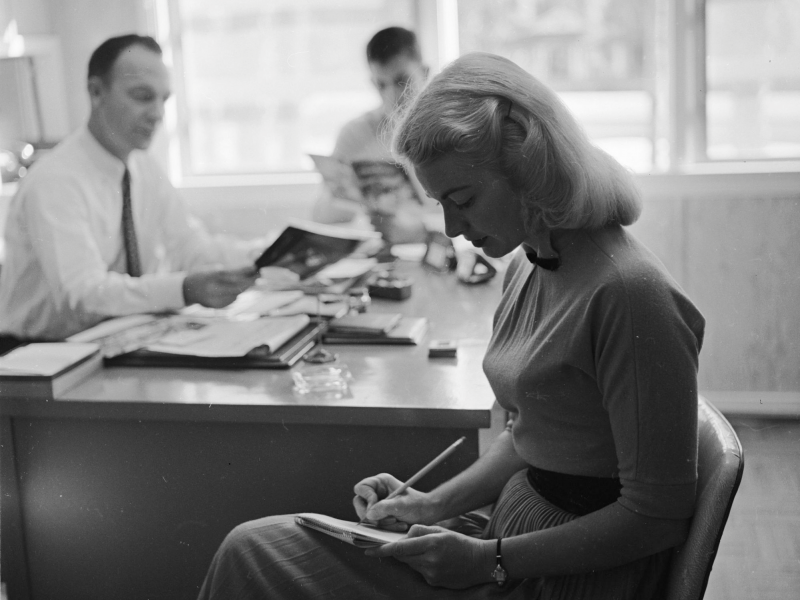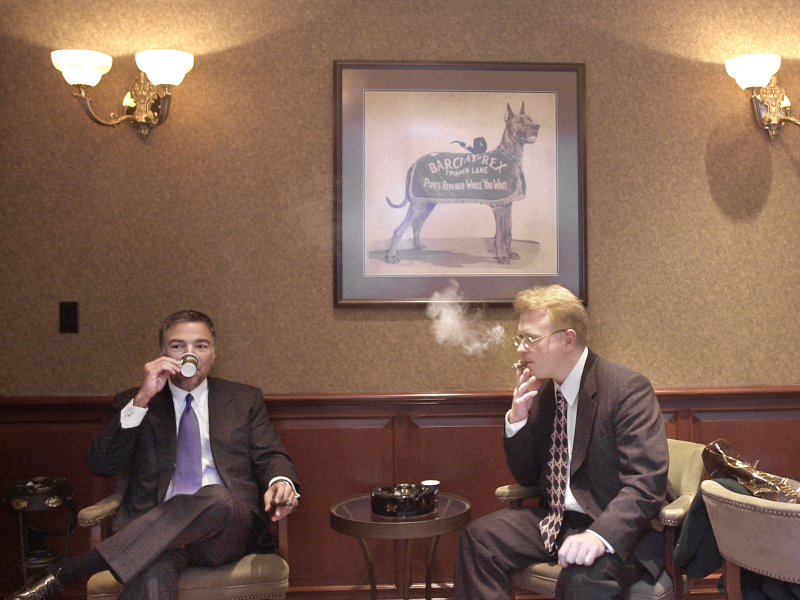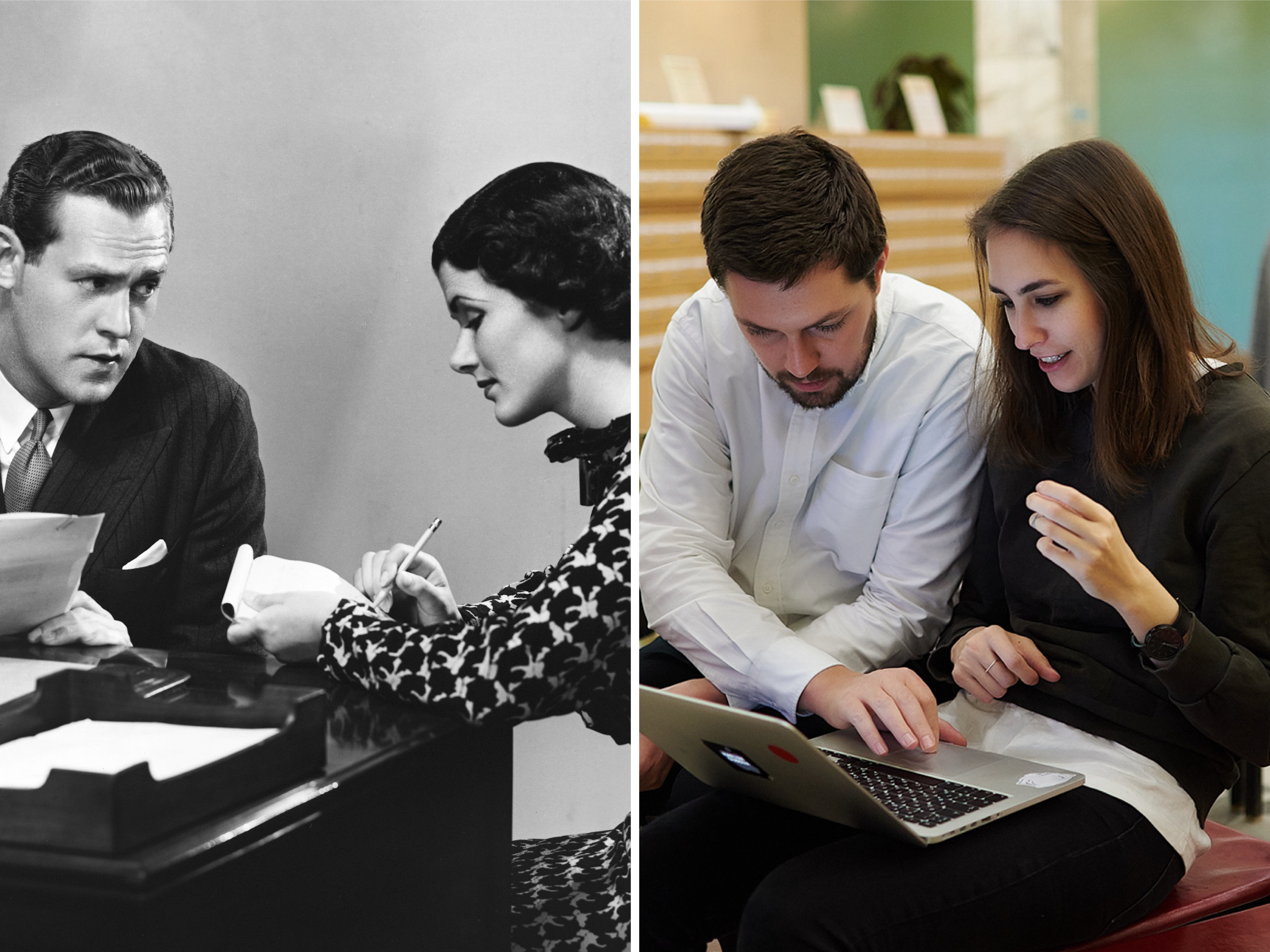- Work clothes have changed a lot over the years.
- Style in general has become less formal since the 1950s.
- Take a look below at how office workers have dressed across the decades.
Why don’t people dress up for work anymore?
It’s a question that’s no doubt popped into the minds of many a workplace fashionista – not to mention anyone French cuffs-deep into a Mad Men binge.
The short answer is… it’s complicated. Even today, degrees of sartorial formality tend to vary between industries, companies, and roles. And workplace styles can change day-to-day on an individual basis, too. Even if you usually don a business casual outfit, chances are, you’ll probably dress up for your career-making pitch to the boardroom.
Basically, fashion’s an ever-evolving, context-specific, and highly-personal thing.
But what accounts for the fact that many industries and companies have been slouching toward casualness since the 1970s?
To find out how - and why - workplace dress has transformed in this century, let's take a look back through time.
In the middle of the 20th century, many offices expected their employees to adhere to what modern workers would consider a formal look.

Source: The Atlantic, Psychology Today
Companies back then were more "process-oriented" than the "results-oriented" organizations of today, according to The Atlantic.

Source: The Atlantic, Psychology Today
Results-oriented organizations care about... well, results. According to Psychology Today, process-oriented companies are "concerned with how that success occurs."

Source: The Atlantic, Psychology Today
As far as workplace fashion is concerned, that means that nowadays, many employers are thrilled as long as you're getting your work done. They care a little less about what you're wearing while completing said work.

Source: The Atlantic, Psychology Today
Meanwhile, employees in the 1950s were largely expected to dress a specific way in a professional setting.

Source: The Atlantic, Psychology Today
So what exactly did our buttoned-up office forebearers wear to work in the 1950s and early 1960s?

Source: The Atlantic
Generally speaking, men sported suits, ties, and overcoats. "Dark suits, white shirts, dark ties, and white pocket squares didn't just dominate — they were practically a requirement in business," according to GQ.

Source: The Atlantic, GQ
And don't forget hats. Hats were a must for men on the go. "Regardless of what he wore, a properly dressed man in the 1950s still had to don a hat," William H. Young and Nancy K. Young wrote in the book "The 1950s."

Source: "The 1950s"
Over the course of the decade, men's suits morphed from looser fits to a "skinny tailored fit style," according to the historical fashion blog Vintage Dancer.

Source: Esquire, Vintage Dancer
Meanwhile, the Youngs wrote that career women typically wore "tailored wool suits over silk blouses." Dresses were also an option for the office. The standard look was completed with hosiery or stockings, as well as shoes with "thin stiletto heels."

Source: Mashable, "The 1950s," Mic
Of course, while the 1950s are often remembered as a time of strict and widespread cultural conformity, not all workplaces were so exacting about dress codes.

Like today, a person's age, role, place of work, and personal preferences would influence how they dressed on the job.

And, while the following decade may have brought about cultural transformation, social upheaval, and hippies, significant changes to workplace fashion didn't happen overnight.

Source: Time
The beginning of the 1960s saw many Americans starting to take cues from the White House on how to dress. The Kennedy administration — with its preppy First Couple — ended up influencing the fashion of the time.

Source: Esquire, Los Angeles Times, Time
Fashion for men has traditionally been more conservative and less subject to change — especially when it comes to business attire. But suits did continue to slim out throughout the decade.

Source: Mashable, Vintage Dancer
Ties became increasingly skinny as well.

Source: Mashable, Vintage Dancer
Over the course of the 1960s, women's office fashion would undergo both subtle and obvious changes. Lola Cherson, who worked in advertising in the 1960s, told The Atlantic, "Back then, we wore nice dresses."

Source: The Atlantic
She added that women would constantly check to ensure that the seams in their stockings were straight. Trousers in the workplace were still rare for women, although they were increasingly popular outside of work.

Source: "Fashion Fads Through American History," "The 1960s," The Atlantic
One fashion trend in particular took on special significance for career-oriented women. Pussy-bow blouses were viewed as a fitting equivalent to the traditional masculine suit-and-tie look. As outgoing Hewlett-Packard CEO Meg Whitman told PBS, "It was our attempt to be feminine but fit into what was then a male world."

The 1960s may have seen some major shifts, but the rollback of formality really began to snowball in the 1970s, as groovy fashions took hold across the country.

Sounds: The New York Times
Of course, the prevailing dress code of a specific workplace was still largely dependent on the nature of the workplace itself. You'd notice major differences between, say, how people dressed in a newsroom and how people dressed in a bank.

Sounds: The New York Times, Business Insider
But the transformation was still seismic, at least in some industries. Longer hair gradually became more acceptable on men...

Source: Hair-and-Makeup.com
... and beards became more of a thing.

Source: Hair-and-Makeup.com
Esquire described the 1970s as the advent of "the peacock revolution" and "loose-collared culture" for working men.

Source: Esquire
Meanwhile, more and more women began swapping out their skirts and dresses for pants in the workplace.

Source: Stuff Mom Never Told You
Many employers continued to implement dress codes, but according to The Atlantic, "often-ignored infractions eroded the sanctity of any top-down policy."

Source: Mashable, The Atlantic
As a result, style in the workplace began to reflect the everyday, far out fashions people gravitated toward.

Source: Mashable, The Atlantic
The 1980s took workplace fashion trends to several tubular new extremes; an unsurprising development, given the decade's penchant for big perms, sequin-encrusted garments, and bright colors.

Source: Newsweek, Harper's Bazaar
In the world of suits, broad-shoulders, bold patterns, and "power ties" ruled the day, according to Esquire.

Source: Esquire
Women in the workplace opted for what Newsweek described as an "exaggerated masculine style of dress," famously epitomized by shoulder pads. Towering high heels also allowed women to attempt to make up for any height differences with their male colleagues.

Source: The Atlantic, Newsweek, The Atlantic
The "power dressing" trend for women carried over into the 1990s, but "the power suit started relaxing," according to Mic. Pantsuits became increasingly popular, as did low-heeled shoes.

Source: Mic
Another trend that carried over from the 1980s was the rise of business casual. The Atlantic defined the initial iteration of the style as a combination of "khaki pants, sensible shoes, and button-down collared shirts," and marked Silicon Valley as its birthplace.

Source: The Atlantic
Silicon Valley proved to be the perfect breeding ground for the casual revolution, according to The Atlantic, given its interest in "discarding norms and celebrating rule-breaking." The look went mainstream in the 1990s.

Source: The Atlantic
For professionals who stuck with a more formal look, Esquire said nineties suits started out with a "loose, baggy silhouette" that transitioned into "a slimmer suit profile" by the early 2000s.

Source: Esquire, The Atlantic
And, as always, workplace dress codes continued to fracture across industries, in terms of formality. Throughout the 2000s, "corporate image and employees' desires helped define who went casual and when," according to The Atlantic.

Source: Esquire, The Atlantic
Today, the fields of finance, law, and accounting tend to require conservative and traditional modes of dress...

Source: Business Insider
... while creative and tech-oriented professions are often more flexible. But, either way, it's no longer unthinkable to see a t-shirt or two in the office.

Source: Business Insider
And, with 70% of professionals telecommuting at least once a week according to global workplace corporation IWG, employees are set to only continue to challenge the boundaries of work dress. After all, no one's going to see that you're wearing pajama bottoms on a Skype call.


